684 RUNNING WITH THE HOUNDS
EARTH-DOGS RUNNING WITH THE HOUNDS
by David Hancock
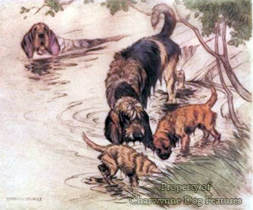
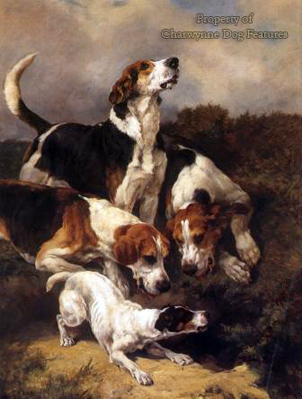 In the early part of the twentieth century, Major Harding Cox was a substantial figure in the canine world, both in the show and the hunting world. In 1928, he wrote a fairly forthright book on dogs, entitled Dogs and I and published by Hutchinson, and had much to say on terriers. He ridiculed the whole concept of breeding leggy terriers capable of running with the hounds, writing that “The theory anent (i.e. concerning, DH) Fox-terriers running with Fox-hounds is a fatuous one.” He considered that such misguided thinking resulted in long-legged badly-constructed terriers no longer capable of being earth-dogs. It is significant to note the physical type of today’s terrier breeds which have survived the quest for terriers which can ‘follow the hunt’, such as Fox and Border Terriers.
In the early part of the twentieth century, Major Harding Cox was a substantial figure in the canine world, both in the show and the hunting world. In 1928, he wrote a fairly forthright book on dogs, entitled Dogs and I and published by Hutchinson, and had much to say on terriers. He ridiculed the whole concept of breeding leggy terriers capable of running with the hounds, writing that “The theory anent (i.e. concerning, DH) Fox-terriers running with Fox-hounds is a fatuous one.” He considered that such misguided thinking resulted in long-legged badly-constructed terriers no longer capable of being earth-dogs. It is significant to note the physical type of today’s terrier breeds which have survived the quest for terriers which can ‘follow the hunt’, such as Fox and Border Terriers.
On Fox Terriers, Harding Cox wrote: “All of a sudden there arose certain wiseacres in the ranks of Fox-terrier breeders who laid down a law, which went near to ruining the breed for good and all. They declared that the type which hitherto had been accepted must be scrapped, and that breeders must at once set about producing dogs which would be fast enough and possess sufficient stamina to run with hounds! Goodness only knows how they expected a Terrier of even 22lb. to run with Fox-hounds and live with them when driving at score on a holding scent! The whole thing was of course impossible, and the theory utterly ridiculous; but there it was! The benches were soon disgraced by long, leggy Terriers…for a long time, the insistence upon exceedingly narrow fronts made shallow chests, weak ribs and ‘wedged’ quarters inevitable!” He would not be amused by show bench Fox Terriers today.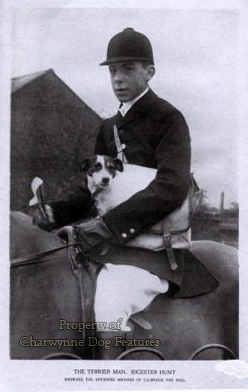
In the breed standard of the Border Terrier, under the characteristics description, there is the phrase ‘capable of following a horse’, which is often interpreted as a requirement for the breed to run with the hounds. But the breed was often employed with foot-hounds not the mounted field. The physical needs of an earth-dog and a running dog are in conflict. I wonder if originally a phrase like ‘able to follow the hunt’, i.e. to support the hounds once the quarry had been located as being underground, was used for terriers working with foot-hounds. The country over which the hunting took place, and where Border Terriers were used, was not always suitable for mounted huntsmen. In similar country, the Scots and the Cumbrians never sought a leggy terrier, able to run with the moving hunt. In his book on terriers of 1896, Rawdon Lee writes: “Some of the terriers follow hounds regularly, and are continually brought into use, not only amongst the rocks and in rough ground of that kind, but in equally or in more dangerous places – wet drains or moss holes, or ‘waterfalls’, as they are called in Northumberland.” Not much scope for mounted huntsmen here!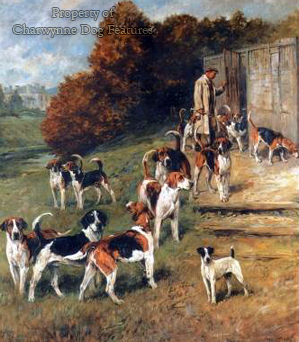
In his informative book on the Border Terrier, Walter JF Gardner queries: “How many of the world’s top athletes are short-legged or short-backed or both? How many animals which go to ground or can gallop and stay long distances have a short back?” It is a question to be answered by Border Terrier devotees. There are obvious conflicts between the anatomy of a scenthound, even a foothound, and that of an earth-dog. It would be a challenge for any breed-designer to set out the blueprint for a sporting dog which could do both effectively; galloping and digging demand different criteria. How can you construct a terrier for which the show bench requires a short back whilst the working role demands a longer one; when the latter expects an animal designed to work underground, with ease, and some huntsmen want them to run with the hounds!
There is a quote in Rawdon Lee’s book on Fox Terriers in which a Capt Handy, a Cotswold sportsman, remarks: “Now in these fast days, sportsmen cannot wait for a fox to be got out, and the order is ‘find another one’; hence the use of fox terriers to run with hounds has been discontinued, and the breed has not been kept up at Badminton.” In his Encyclopaedia of Rural Sports of 1870, Delabere Blaine was writing: “Terriers, we have already stated, were formerly very commonly used to accompany packs of foxhounds for the purpose of unearthing the fox…They were usually of a medium size; if too large, they were unfitted for penetrating the sinuosities of an earth, or creeping up a confined drain; if, on the contrary, they are too diminutive, they cannot keep pace with the hounds of the present day…in some few packs, however, both large and small terriers still accompany the dogs.”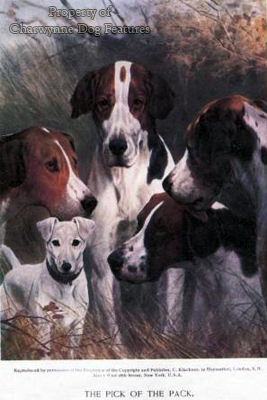
Fox Terriers were not always of uniform height, even in the show ring. From 1876 and for a decade after, there were separate classes for dogs over and under 18lbs, and for bitches over and under 16lbs. At a show in 1875, one of Rawdon Lee’s winning dogs weighed under 15lbs. There was more concern over construction than size itself. Rawdon Lee wrote: “there are judges who have recently gone to extremes in awarding honours to these so-called ‘narrow-fronted’ terriers. Such have been produced at a sacrifice of power and strength. Most of these very narrow-chested dogs move stiffly, are too flat in the ribs, they are deficient in breathing and heart room, and can never be able to do a week’s hard working the country, either with hounds or round about the badger earth or rabbit burrows.” The show ring Fox Terrier of today would have depressed him.
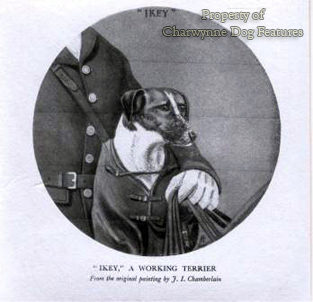 The Fox Terrier of today is required by its breed standard to not to exceed 15 and a half inches at the withers, with an ideal weight of 18lbs, both for dogs and slightly less for bitches. The Border Terrier, on the other hand, is required to weigh from 13 to 15 and a half pounds, and, according to its KC-approved description to have “the stamina to keep up with a horse, in order that he will be there when he’s needed.” A Foxhound is around two feet at the withers and a man needs a horse to keep pace with one. Beagles are not expected to match a horse’s pace but be 13 to 16 inches at withers. Leg length affects an animal’s pace and the number of strides it takes affects its stamina. No doubt a gutsy terrier will do its utmost to keep up with galloping hounds if asked to, but why impair its earth-dog capability by expecting it to run with hounds too? It imposes needless handicaps on the dog as a terrier and in striving to be a hound as well, produces a composite anatomy unfitted for both roles. Both terriers and hounds can be designed for a specific hunting country and quarry but dual-purpose can so often result in ‘not fit for purpose’. Daniel tells us of a match run in 1874 for a huge stake, in which a quite small terrier ran a mile in two minutes and six miles in eighteen minutes. He doesn’t record whether the dog was any good underground!
The Fox Terrier of today is required by its breed standard to not to exceed 15 and a half inches at the withers, with an ideal weight of 18lbs, both for dogs and slightly less for bitches. The Border Terrier, on the other hand, is required to weigh from 13 to 15 and a half pounds, and, according to its KC-approved description to have “the stamina to keep up with a horse, in order that he will be there when he’s needed.” A Foxhound is around two feet at the withers and a man needs a horse to keep pace with one. Beagles are not expected to match a horse’s pace but be 13 to 16 inches at withers. Leg length affects an animal’s pace and the number of strides it takes affects its stamina. No doubt a gutsy terrier will do its utmost to keep up with galloping hounds if asked to, but why impair its earth-dog capability by expecting it to run with hounds too? It imposes needless handicaps on the dog as a terrier and in striving to be a hound as well, produces a composite anatomy unfitted for both roles. Both terriers and hounds can be designed for a specific hunting country and quarry but dual-purpose can so often result in ‘not fit for purpose’. Daniel tells us of a match run in 1874 for a huge stake, in which a quite small terrier ran a mile in two minutes and six miles in eighteen minutes. He doesn’t record whether the dog was any good underground!